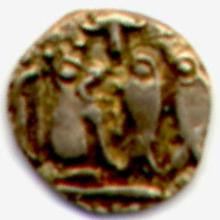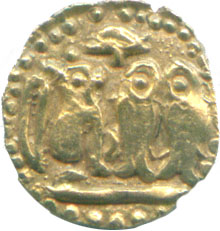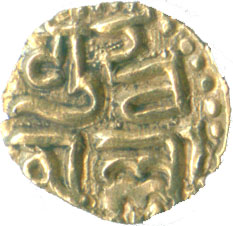| SPECIFICATIONS | |
| Denomination | One Tenth |
| Metal | Gold 0.38 |
| Alloy | Ag%Cu = 0.59 |
| Type | Struck |
| Diameter | 8.6 mm |
| Thickness | 1.1 mm |
| Weight | 0.48 gms |
| DieAxis | O° |


|

| 
| ||||||||||||||||||
| Rajendra Chola | Mitchiner #728 ; Biddulph #29 | |||||||||||||||||||
|

| 
| ||||||||||||||||
| Rajendra Chola | Mitchiner #728 ; Biddulph #29 |
The emblem of a "tiger facing two fish" was adopted by Uttam Chola (973-985) of Thanjavur in ThamilNadu. The seated tiger represented the Chola homeland, and the fish for the Pandya conquest. The fish on the Pandyan coins are horizontal (swimming) and in this case vertical (dead). The title Yuddhamalla was adopted by RajaRaja Chola's son Rajendra Chola (1014-1044). Rajaraja Chola invaded Lanka in 990 CE and conquered the northern half. Ruining Anuradhapura he made Polonnaruwa his capital on the island;. Rajendra Chola succeeded in extended Chola occupation over the whole island of Lanka in 1018. The "seated king" design of Lankan masaka became the model for subsequent Chola coins. Lanka became regained independence from Chola occupation in 1070 under Vijaya-bahu (1055-1110).
Codrington on page 84, states " a very few with the legend Yuddha mallah (Coins of Southern India, Sir W. Elliot No. 155), of poor gold seem to have been found in the island.".
The coin is discussed by Biddulph in his 1966 monogram on
Coins of the Cholas. It's weight is one tenth of a Madai
coin and 25% smaller than the
Lankan gold aka (one eighth)
coin.
The Chalukyan, ruler named Yuddhamalla II (AD 928-935)
much earlier than the Chola conquest of Vengi, after only which the group of
symbols occurring on these coins are seen on Chalukya-Chola coins.
This coin could have been struck by Rajendra I Chola as a special issue
at the time of the marriage of his daughter to the Chalukya Raja Raja Narendra
(AD 1019-1061), the father of Rajendra II (Chalukya), who was known subsequently
as Kulottunga I (Chola) (AD 1070-1118).
The gold coin was scanned at 600 dpi and displayed at 600 dpi. Coin-1 was purchased on ebay in Sept 1999 from a seller who had purchased from a Auction by Harlan Berk of Chicago, who however atributed it to 12-14th century. Coin-2 was obtained within a lot from a collector Lalith Raddella in 2015 August.
IMHO image of the tiger is face-on, with the two eyes represented by the two dots at 10 - 11 O'clock. The larger dot inside is the mouth with the nose and wiskers represented by lines in between. see it ... Since designs often became more stylised with time this coin is probably an older issue.
See also base gold kasu coin of Ragendra Chola. The original "seated Tiger" design is from the Uttama Chola (973 - 985) silver kasu coin.
Text edited from
* Coins of the Cholas: C. H. Biddulph, NSI #13, 1966.
* Oriental Coins: Michael Mitchiner,
London, Hawkins Publications, 1978.